CO2 Emissions and Macroeconomic Indicators: Analysis of the Most Polluted Regions in the World
Abstract
1. Introduction
2. Literature Review
2.1. Theoretical Background
2.2. GDP, Export, Import, and CO2 Emissions
2.3. Inflation and CO2 Emissions
2.4. Unemployment and CO2 Emissions
3. Materials and Methods
4. Results
4.1. The Impact of Macroeconomic Indicators on CO2 Emissions in the United States
- The correlation between CO2 emission volumes and the exports volume is 0.427974.
- The correlation between CO2 emission volumes and GDP is 0.481560.
- The correlation between CO2 emission volumes and the imports volume is 0.483338.
- The correlation between CO2 emission volumes and the inflation rate is −0.406354.
- The correlation between CO2 emission volumes and the unemployment rate is −0.431853.
- If all the independent variables equal zero, US CO2 emissions will be 5,507,271.9816 kt.
- If the volume of exports increases by USD 1, CO2 emissions will decrease by 1.7 × 10−6 kt.
- If the volume of imports increases by USD 1, CO2 emissions will increase by 1.42 × 10−6 kt.
- If the inflation rate increases by 1%, CO2 emissions will decrease by 27,190.6 kt. However, as it can be seen from the regression equation, this figure is insignificant (Prob. > 0.05).
- If the unemployment rate increases by 1%, CO2 emissions will decrease by 87,566.8 kt.
4.2. The Impact of Macroeconomic Indicators on CO2 Emissions in the Asia-Pacific Region (APAC)
- The correlation between CO2 emission volumes and the volume of exports equals 0.993555.
- The correlation between CO2 emission volumes and GDP equals 0.970408.
- The correlation between CO2 emission volumes and the volume of exports imports equals 0.988110.
- The correlation between CO2 emission volumes and the rate of inflation is −0.565898.
- The correlation between CO2 emission volumes and the unemployment rate is 0.441368.
- If all independent variables equal zero, the CO2 emissions in the Asia-Pacific region will be 3,968,322.1983 kt.
- If the volume of exports increases by USD 1, the CO2 emissions will increase by 2.81 × 10−6 kt.
- If the volume of imports increases by USD 1, the CO2 emissions will decrease by 1.5 × 10−6 kt.
- If the inflation rate increases by 1%, the CO2 emissions will decrease by 98,154.3 kt.
- If the unemployment rate increases by 1%, the CO2 emissions will increase by 208,544.1 kt. However, as it can be seen from the regression equation, this figure is insignificant (Prob. > 0.05).
5. Discussion
- -
- which sectors of the economy are responsible for CO2 production;
- -
- how macroeconomic indicators change over time;
- -
- in which economic sectors there is the greatest change in CO2 in terms of their production;
- -
- how changes in production in one sector of the economy affect emissions not only in this sector but also (through the purchase of raw materials) in other sectors.
6. Conclusions and Policy Implications
- The correlation between CO2 emission volume and exports volume is medium and direct for the United States, whereas it is significant and direct for the Asia-Pacific region.
- The correlation between CO2 emission volume and GDP for the United States and the Asia-Pacific region is significant and direct.
- The correlation between CO2 emission volume and imports volume is medium and direct for the United States, whereas it is significant and direct for the Asia-Pacific region.
- The correlation between CO2 emission volume and the inflation rate for the US and the Asia-Pacific region is medium and indirect.
- The correlation between the CO2 emission volume and the unemployment rate is significant and indirect for the United States, whereas it is significant and direct for the Asia-Pacific region.
Author Contributions
Funding
Institutional Review Board Statement
Informed Consent Statement
Data Availability Statement
Conflicts of Interest
References
- Petty, G.W. A First Course in Atmospheric Radiation; Sundog Publishing: Madison, WI, USA, 2004. [Google Scholar]
- Kasemsap, K. Global warming and climate change: Challenges and impacts. In Effective Solutions to Pollution Mitigation for Public Welfare; Gezerman, A., Corbacioglu, B., Gurjar, B., Eds.; IGI Global: Hershey, PA, USA, 2018; pp. 44–68. [Google Scholar] [CrossRef]
- Hansen, J.; Ruedy, R.; Sato, M.; Lo, K. Global surface temperature change. Rev. Geophys. 2010, 48, RG4004. [Google Scholar] [CrossRef]
- Mariyakhan, K.; Mohamued, E.A.; Khan, M.A.; Popp, J.; Oláh, J. Does the Level of Absorptive Capacity Matter for Carbon Intensity? Evidence from the USA and China. Energies 2020, 13, 407. [Google Scholar] [CrossRef]
- Pearce, D.W.; Markandya, A.; Babier, E. Blueprint for a Green Economy; Earthscan: London, UK, 1989. [Google Scholar]
- Tiseo, I. Global Carbon Dioxide Emissions 1965–2020, by Region. Available online: https://www.statista.com/statistics/205966/world-carbon-dioxide-emissions-by-region (accessed on 12 January 2022).
- Kozlovskyi, S.; Petrunenko, I.; Baidala, V.; Myronchuk, V.; Kulinich, T. Assessment of public welfare in Ukraine in the context of the COVID-19 pandemic and economy networkization. Probl. Perspect. Manag. 2021, 19, 416–431. [Google Scholar] [CrossRef]
- Baeten, G.; Swyngedouw, E.; Albrechts, L. Politics, Institutions and Regional Restructuring Processes: From Managed Growth to Planned Fragmentation in the Reconversion of Belgium’s Last Coal Mining Region. Reg. Stud. 1999, 33, 247–258. [Google Scholar] [CrossRef]
- Florek-Paszkowska, A.; Ujwary-Gil, A.; Godlewska-Dzioboń, B. Business innovation and critical success factors in the era of digital transformation and turbulent times. J. Entr. Manag. Innov. 2021, 17, 7–28. [Google Scholar] [CrossRef]
- Gajdzik, B.; Grabowska, S.; Saniuk, S. Key socio-economic megatrends and trends in the context of the Industry 4.0 framework. Forum Sci. Oecon. 2021, 9, 5–22. [Google Scholar] [CrossRef]
- Astawa, I.K.; Pirzada, K.; Budarma, K.; Istri, C.; Widhari, S.; Agung, A.; Suardani, P. The effect of green supply chain management practices on the competitive advantages and organizational performance. Polish J. Manag. Stud. 2021, 24, 45–60. [Google Scholar] [CrossRef]
- Fu, Q.; Álvarez-Otero, S.; Sial, M.S.; Comite, U.; Zheng, P.; Samad, S.; Oláh, J. Impact of renewable energy on economic growth and CO2 emissions—evidence from BRICS countries. Processes 2021, 9, 1281. [Google Scholar] [CrossRef]
- Ahmad, M.; Ahmed, Z.; Bai, Y.; Qiao, G.; Popp, J.; Oláh, J. Financial Inclusion, Technological Innovations, and Environmental Quality: Analyzing the Role of Green Openness. Front. Environ. Sci. 2022, 10, 851263. [Google Scholar] [CrossRef]
- Li, N.; Kang, R.; Feng, C.; Wang, C.; Zhang, C. Energy structure, economic growth, and carbon emissions: Evidence from Shaanxi province of China (1990–2012). Forum Sci. Oecon. 2017, 5, 79–93. [Google Scholar] [CrossRef]
- Potoczek, N.R. The use of process benchmarking in the water industry to introduce changes in the digitization of the company’s value chain. J. Ent. Manag. Innov. 2021, 17, 51–89. [Google Scholar] [CrossRef]
- Kabir, A.; Gilani, S.M.; Rehmanc, G.; Sabath, H.S.; Popp, J.; Hassan, M.A.S.; Oláh, J. Energy-aware caching and collaboration for green communication systems. Acta Montan. Slovaca 2021, 26, 47–59. [Google Scholar]
- Hancher, L.; Ottervanger, T.; Slot, P. EU State Aids; Sweet & Maxwell: London, UK, 2012. [Google Scholar]
- Halkiv, L.; Kulyniak, I.; Shevchuk, N.; Kucher, L.; Horbenko, T. Information Support of Enterprise Management: Diagnostics of Crisis Situations. In Proceedings of the 11th International Conference on Advanced Computer Information Technologies, Deggendorf, Germany, 15–17 September 2021; pp. 309–312. [Google Scholar] [CrossRef]
- Rozum, R.; Liubezna, I.; Kalchenko, O. Improving efficiency of using agricultural land. Sci. Bull. Polissia 2017, 3, 193–196. [Google Scholar] [CrossRef][Green Version]
- Dziadykevych, Y.; Buriak, M.; Rozum, R.; Liubezna, I.; Duda, B. Aspects of multi-method management of natural resources. Inn. Sol. Mod. Sci. Int. J. 2017, 2, 27–43. [Google Scholar]
- McCormick, J. Environmental Policy in the European Union; Palgrave: London, UK, 2001. [Google Scholar] [CrossRef]
- Johnson, S.P.; Corcelle, G. The Environmental Policy of the European Communities; Kluwer Law International: London, UK, 1995. [Google Scholar]
- Horbatenko, V. Club of Rome and organization of transdisciplinary projects for long-term forecasting of global problems. Politic. Manag. 2012, 3, 52–64. [Google Scholar]
- Meadows, D.; Randers, J.; Meadows, D. Limits to Growth. The 30-Year Update; Earthscan: London, UK, 2006. [Google Scholar]
- Methodology of System Dynamics of J. Forrester. Available online: http://studies.in.ua/mpd_seminar/1312-metodologya-sistemnoyi-dinamki-dzhforrestera.html (accessed on 23 January 2022).
- Dan, H. Culturally green–an investigation into the cultural determinants of environmental performance. Forum Sci. Oecon. 2019, 7, 107–126. [Google Scholar] [CrossRef]
- Gajdzik, B.; Sroka, W.; Vveinhardt, J. Energy Intensity of Steel Manufactured Utilising EAF Technology as a Function of Investments Made: The Case of the Steel Industry in Poland. Energies 2021, 14, 5152. [Google Scholar] [CrossRef]
- Gajdzik, B.; Sroka, W. Resource intensity vs. investment in production installations-the case of the steel industry in Poland. Energies 2021, 14, 443. [Google Scholar] [CrossRef]
- Prokopenko, O.; Miśkiewicz, R. Perception of "Green Shipping" in the contemporary conditions. Ent. Sust. Issues 2020, 8, 269–284. [Google Scholar] [CrossRef]
- Androniceanu, A. Social responsibility, an essential strategic option for a sustainable development in the field of bio-economy. Amfiteatru Econ. 2019, 21, 503–519. [Google Scholar] [CrossRef]
- Shpak, N.; Melnyk, O.; Horbal, N.; Ruda, M.; Sroka, W. Assessing the implementation of the circular economy in the EU countries. Forum Sci. Oecon. 2021, 9, 25–39. [Google Scholar] [CrossRef]
- Ernst & Young. Available online: https://www.ey.com/en_gl (accessed on 23 January 2022).
- Nelson, A.; Coffey, B. What Is ‘Ecological Economics’ and Why Do We Need to Talk About It? Available online: https://theconversation.com/what-is-ecological-economics-and-why-do-we-need-to-talk-about-it-123915 (accessed on 23 January 2022).
- Farooq, S.; Ozturk, I.; Majeed, M.T.; Akram, R. Globalization and CO2 Emissions in the Presence of EKC: A Global Panel Data Analysis. Gondwana Res. 2022, in press. [Google Scholar] [CrossRef]
- Ampon-Wireko, S.; Zhou, L.; Xu, X.; Dauda, L.; Adjei Mensah, I.; Larnyo, E.; Baah Nketiah, E. The relationship between healthcare expenditure, CO2 emissions and natural resources: Evidence from developing countries. J. Environ. Econ. Policy 2021, 1–15. [Google Scholar] [CrossRef]
- Acheampong, A.; Amponsah, M.; Boateng, E. Does financial development mitigate carbon emissions? Evidence from heterogeneous financial economies. Energy Econ. 2020, 88, 104768. [Google Scholar] [CrossRef]
- Holz, F.; Scherwath, T.; del Granado, P.C.; Skar, C.; Olmos, L.; Ploussard, Q.; Ramos, A.; Herbst, A. A 2050 perspective on the role for carbon capture and storage in the European power system and industry sector. Energy Econ. 2021, 104, 105631. [Google Scholar] [CrossRef]
- Can, M.; Gozgor, G. The impact of economic complexity on carbon emissions: Evidence from France. Environ. Sci. Pollut. Res. 2017, 24, 16364–16370. [Google Scholar] [CrossRef]
- Hou, J.; Deng, X.; Han Springer, C.; Teng, F. A global analysis of CO2 and non-CO2 GHG emissions embodied in trade with Belt and Road Initiative countries. Ecosyst. Health Sustain. 2020, 6, 1761888. [Google Scholar] [CrossRef]
- Neagu, O.; Teodoru, M.C. The Relationship between Economic Complexity, Energy Consumption Structure and Greenhouse Gas Emission: Heterogeneous Panel Evidence from the EU Countries. Sustainability 2019, 11, 497. [Google Scholar] [CrossRef]
- Leitão, N.C.; Balsalobre-Lorente, D.; Cantos-Cantos, J.M. The Impact of Renewable Energy and Economic Complexity on Carbon Emissions in BRICS Countries under the EKC Scheme. Energies 2021, 14, 4908. [Google Scholar] [CrossRef]
- OECD. Green Growth Indicators. Available online: https://stats.oecd.org/Index.aspx?DataSetCode=GREEN_GROWTH (accessed on 23 January 2022).
- Nazarko, Ł.; Žemaitis, E.; Wróblewski, Ł.K.; Šuhajda, K.; Zajączkowska, M. The Impact of Energy Development of the European Union Euro Area Countries on CO2 Emissions Level. Energies 2022, 15, 1425. [Google Scholar] [CrossRef]
- UBTA. Calculation of Greenhouse Gas Emissions in Ukraine Until 2030. Available online: https://ubta.com.ua/files/20210713/Annex_2.pdf (accessed on 23 January 2022).
- Androniceanu, A. Major structural changes in the EU policies due to the problems and risks caused by COVID-19. Adm. Manag. Public 2020, 34, 137–149. [Google Scholar] [CrossRef]
- Oláh, J.; Krisán, E.; Kiss, A.; Lakner, Z.; Popp, J. PRISMA Statement for Reporting Literature Searches in Systematic Reviews of the Bioethanol Sector. Energies 2020, 13, 2323. [Google Scholar] [CrossRef]
- Voitko, S.V.; Zainchkovska, M.M. State and Prospects of Energy Development as a Sphere of Quality Assurance and Life Safety. 2021. Available online: http://ev.fmm.kpi.ua/article/view/231975 (accessed on 29 January 2022).
- Prokopenko, O.; Korchevska, L.; Shulga, M.; Zakharchenko, A.; Staverska, T.; Sydorov, Y. Adaptation of the development of ecological entrepreneurship. Int. J. Sci. Technol. Res. 2020, 9, 1112–1115. [Google Scholar]
- Hübler, M.; Keller, A. Energy savings via FDI? Empirical evidence from developing countries. Environ. Dev. Econ. 2010, 15, 59–80. [Google Scholar] [CrossRef]
- Buyak, L.M.; Hrihorkiv, M.V. Dynamic model of the economy taking into account the economic structure of society and the greening of production. Collect. Sci. Works Econ. 2009, 494, 139–143. [Google Scholar]
- Hrihorkiv, M.V. Two-sector model of ecological and economic dynamics in the conditions of economic clustering of society. Financial system of Ukraine. Collect. Sci. Works 2011, 16, 585–591. [Google Scholar]
- Pauchok, V.K.; Buyak, V.K.; Hrihorkiv, M.V. Parameterization of mathematical models of ecological and economic systems in the space of indicators of economic structure of society, prices and environmental pollution. Inn. Econ. 2013, 7, 329–334. [Google Scholar]
- Karyy, O.; Kulyniak, I.; Struchok, N.; Halkiv, L.; Ohinok, S. Evaluation of the Tourist Attractiveness of Ukraine’s Regions in the Conditions of Uncertainty Using Game Theory. In Proceedings of the 11th International Conference on Advanced Computer Information Technologies, Deggendorf, Germany, 15–17 September 2021; pp. 351–355. [Google Scholar] [CrossRef]
- Mohsin, M.; Naseem, S.; Sarfraz, M.; Azam, T. Assessing the effects of fuel energy consumption, foreign direct investment and GDP on CO2 emission: New data science evidence from Europe & Central Asia. Fuel 2022, 314, 123098. [Google Scholar] [CrossRef]
- Daysi, G.; Karla, M.-M.; Paco, A.-S.; Santiago, O.-M. CO2 emissions, High-tech exports and GDP per capita. In Proceedings of the 16th Iberian Conference on Information Systems and Technologies, CISTI, Chaves, Portugal, 23 June 2021. [Google Scholar] [CrossRef]
- Menyah, K.; Wolde-Rufael, Y. Energy consumption, pollutant emissions and economic growth in South Africa. Energy Econ. 2010, 32, 1374–1382. [Google Scholar] [CrossRef]
- Nazirah Wahid, I.; Abd Aziz, A.; Hashim Nik, M.N. Energy consumption, economic growth and CO2 emissions in selected ASEAN countries. Pros. Perkem 2013, 2, 758–765. [Google Scholar]
- Razak, M.; Ahmad, I.; Bujang, I.; Talib, A.; Ibrahim, Z. IPAT-Fuzzy model in measuring air pollution: Evidence from Malaysia. Am. Int. J. Contemp. Res. 2013, 3, 62–69. [Google Scholar]
- Zhou, R.; Li, S. A study on the development of low-carbon economy in shandong province-based on empirical analysis on the influence factor of carbon emission. Energy Procedia 2011, 5, 2152–2159. [Google Scholar]
- Zubair, A.O.; Abdul Samad, A.-R.; Dankumo, A.M. Does gross domestic income, trade integration, FDI inflows, GDP, and capital reduces CO2 emissions? An empirical evidence from Nigeria. Curr. Res. Environ. Sustain. 2020, 2, 100009. [Google Scholar] [CrossRef]
- Do, T.; Dinh, H. Short-and long-term effects of GDP, energy consumption, FDI, and trade openness on CO2 emissions. Accounting 2020, 6, 365–372. [Google Scholar] [CrossRef]
- Mahmood, H.; Alkhateeb, T.T.Y.; Furqan, M. Exports, imports, Foreign Direct Investment and CO2 emissions in North Africa: Spatial analysis. Energy Rep. 2020, 6, 2403–2409. [Google Scholar] [CrossRef]
- Al-mulali, U.; Sheau-Ting, L. Econometric analysis of trade, exports, imports, energy consumption and CO2 emission in six regions. Renew. Sustain. Energy Rev. 2014, 33, 484–498. [Google Scholar] [CrossRef]
- Haug, A.A.; Ucal, M. The Role of Trade and FDI for CO2 Emissions in Turkey: Nonlinear Relationships. Energy Econ. 2019, 81, 297–307. [Google Scholar] [CrossRef]
- Prichett, M.; Griesmyer, P.; Mcdonald, D.; Venters, V.; Dysert, L. AACE International Certified Cost Technician Primer; AACE International, Inc.: Morgantown, WV, USA, 2011. [Google Scholar]
- Amadeo, K. Inflation, How It’s Measured and Managed. 2020. Available online: https://www.thebalance.com/what-is-inflation-how-it-s-measured-and-managed-3306170 (accessed on 23 January 2022).
- Musarat, M.A.; Alaloul, W.S.; Liew, M.S.; Maqsoom, A.; Qureshi, A.H. Investigating the impact of inflation on building materials prices in construction industry. J. Build. Eng. 2020, 32, 101485. [Google Scholar] [CrossRef]
- Musarat, M.A.; Alaloul, W.S.; Liew, M.S.; Maqsoom, A.; Qureshi, A.H. The Effect of Inflation Rate on CO2 Emission: A Framework for Malaysian Construction Industry. Sustainability 2021, 13, 1562. [Google Scholar] [CrossRef]
- Setyadharma, A.; Oktavilia1, S.; Sri Wahyuningrum, I.F.; Indah Nikensari, S.; Mei Saputra, A. Does Inflation Reduce Air Pollution? Evidence from Indonesia. In Proceedings of the The 6th International Conference on Energy, Environment, Epidemiology, and Information System (ICENIS), Semarang, Indonesia, 4–5 August 2021. [Google Scholar] [CrossRef]
- Ronaghi, M.; Reed, M.; Saghaian, S. The impact of economic factors and governance on greenhouse gas emission. Environ. Econ. Policy Stud. 2020, 22, 153–172. [Google Scholar] [CrossRef]
- Wahidah, N.L.; Antriyandarti, E. Impact of climate change and Coronavirus Disease (COVID-19) on inflation in Indonesia. IOP Conf. Ser. Earth Environ. Sci. 2021, 724, 012105. [Google Scholar] [CrossRef]
- Mrabet, A.; Jarboui, S. Do institutional factors affect the efficiency of GDP and CO2 emission? Evidence from Gulf and Maghreb countries. Int. J. Glob. Energy Issues 2017, 40, 259. [Google Scholar] [CrossRef]
- Liu, Y.Q.; Feng, C. The effects of nurturing pressure and unemployment on carbon emissions: Cross-country evidence. Environ. Sci. Pollut. Res. 2022, 1–20. [Google Scholar] [CrossRef] [PubMed]
- Naqvi, S.; Wang, J.; Ali, R. Towards a green economy in Europe: Does renewable energy production has asymmetric effects on unemployment? Environ. Sci. Pollut. Res. 2022, 29, 18832–18839. [Google Scholar] [CrossRef]
- Ibrahiem, D.M.; Sameh, R. How do clean energy sources and financial development affect unemployment? Empirical evidence from Egypt. Environ. Sci. Pollut. Res. 2020, 27, 22770–22779. [Google Scholar] [CrossRef]
- Kryeziu, L.; Bağiş, M.; Kurutkan, M.N.; Krasniqi, B.A.; Haziri, A. COVID-19 impact and firm reactions towards crisis: Evidence from a transition economy. J. Entr. Manag. Innov. 2022, 18, 169–196. [Google Scholar] [CrossRef]
- Keogh, D.; Johnson, D.K.N. Survival of the funded: Econometric analysis of startup longevity and success. J. Entr. Manag. Innov. 2021, 17, 29–49. [Google Scholar] [CrossRef]
- Nakonechnyi, S.I.; Tereshchenko, T.O.; Romaniuk, T.P. Econometrics; KNEU: Kyiv, Ukraine, 2004. [Google Scholar]
- Karyy, O.I.; Podvalna, H.V. Relationship dominanting of automobile transportation companies: The need of establishing mutual understanding with a client. Actual Probl. Econ. 2016, 184, 149–158. [Google Scholar]
- Dolinskyi, L.B.; Rybachok, O.S. Correlation-regression analysis of investment attractiveness of agro-industrial complex. EconAnalysis Collect. Sci. Works 2016, 24, 30–37. [Google Scholar]
- World Bank Group. Official Web Site of the World Bank Group. Available online: https://www.worldbank.org/en/home (accessed on 23 January 2022).
- Ramseur, J.L. U.S. Carbon Dioxide Emissions Trends and Projections: Role of the Clean Power Plan and Other Factors. 2017. Available online: https://sgp.fas.org/crs/misc/R44451.pdf (accessed on 2 February 2022).
- Nagurskyy, O.; Krylova, H.; Vasiichuk, V.; Kachan, S.; Dziurakh, Y.; Nahursky, A.; Paraniak, N. Safety Usage of Encapsulated Mineral Fertilizers Based on Polymeric Waste. Ecol. Eng. Environ. Technol. 2022, 23, 156–161. [Google Scholar] [CrossRef]
- Chukhrai, N.I.; Sorochak, O.Z.; Bokhonko, I.V. Methodical approaches to distribution of resources of an energy supplying company to reduce operational losses. Nauk. Visn. Nats. Hirn. Univers. 2019, 4, 128–133. [Google Scholar] [CrossRef]
- Lin, C.; Zhang, L.; Zhang, Z. The impact of the rise of emerging economies on global industrial CO2 emissions: Evidence from emerging economies in regional comprehensive economic partnership. Resour. Conserv. Recycl. 2022, 177, 106007. [Google Scholar] [CrossRef]
- Saidi, K.; Mbarek, M.B. The impact of income, trade, urbanization, and financial development on CO2 emissions in 19 emerging economies. Environ. Sci. Pollut. Res. 2017, 24, 12748–12757. [Google Scholar] [CrossRef] [PubMed]
- Sun, H.; Samuel, C.A.; Amissah, J.C.K.; Taghizadeh-Hesary, F.; Mensah, I.A. Non-linear nexus between CO2 emissions and economic growth: A comparison of OECD and B&R countries. Energy 2020, 212, 118637. [Google Scholar] [CrossRef]
- U.S. Department of Commerce Economics and Statistics Administration. U.S. Carbon Dioxide Emissions and Intensities over Time: A Detailed Accounting of Industries, Government and Households. 2010. Available online: https://www.commerce.gov/sites/default/files/migrated/reports/co2reportfinal.pdf (accessed on 27 January 2022).
- Volchyn, I.; Haponych, L. Carbon dioxide emissions at the Ukrainian pulverized-coal thermal power plants. Sci. Works NUFT 2018, 24, 131–142. [Google Scholar] [CrossRef]
- Sharko, V.; Andrusenko, N. Algorithm for estimating factors influencing intensification of production of industrial enterprises. Econ. Ann.-XXI 2017, 162, 68–72. [Google Scholar] [CrossRef]
- Wąs, A.; Sulewski, P.; Krupin, V.; Popadynets, N.; Malak-Rawlikowska, A.; Szymańska, M.; Skorokhod, I.; Wysokiński, M. The potential of agricultural biogas production in Ukraine–impact on GHG emissions and energy production. Energies 2020, 13, 5755. [Google Scholar] [CrossRef]
- Parasyuk, N.V.; Lebid, M.V. Prospects of implementing the internal system of quota trade for greenhouse gas emission in Ukraine. Probl. Gen. Energy 2019, 2, 53–59. [Google Scholar] [CrossRef]
- Nekrasenko, L.; Prokopenko, O.; Aranchiy, V. Carbon Tax as an Instrument of Environmental Management in Ukraine. Act. Probl. Econ. 2015, 165, 196–202. [Google Scholar]
- Mohamued, E.A.; Ahmed, M.; Pypłacz, P.; Liczmańska-Kopcewicz, K.; Khan, M.A. Global Oil Price and Innovation for Sustainability: The Impact of R&D Spending, Oil Price and Oil Price Volatility on GHG Emissions. Energies 2021, 14, 1757. [Google Scholar] [CrossRef]
- Sotnyk, I.; Kurbatova, T.; Kubatko, O.; Prokopenko, O.; Prause, G.; Kovalenko, Y.; Trypolska, G.; Pysmenna, U. Energy Security Assessment of Emerging Economies under Global and Local Challenges. Energies 2021, 14, 5860. [Google Scholar] [CrossRef]
- Shpak, N.; Dvulit, Z.; Maznyk, L.; Mykytiuk, O.; Sroka, W. Validation of ecologists in enterprise management system: A case study analysis. Polish J. Manag. Stud. 2019, 19, 376–390. [Google Scholar] [CrossRef]
- Androniceanu, A.; Tvaronavičienė, M. Developing a holistic system for social assistance services based on effective and sustainable partnerships. Adm. Manag. Publ. 2019, 33, 103–118. [Google Scholar] [CrossRef]
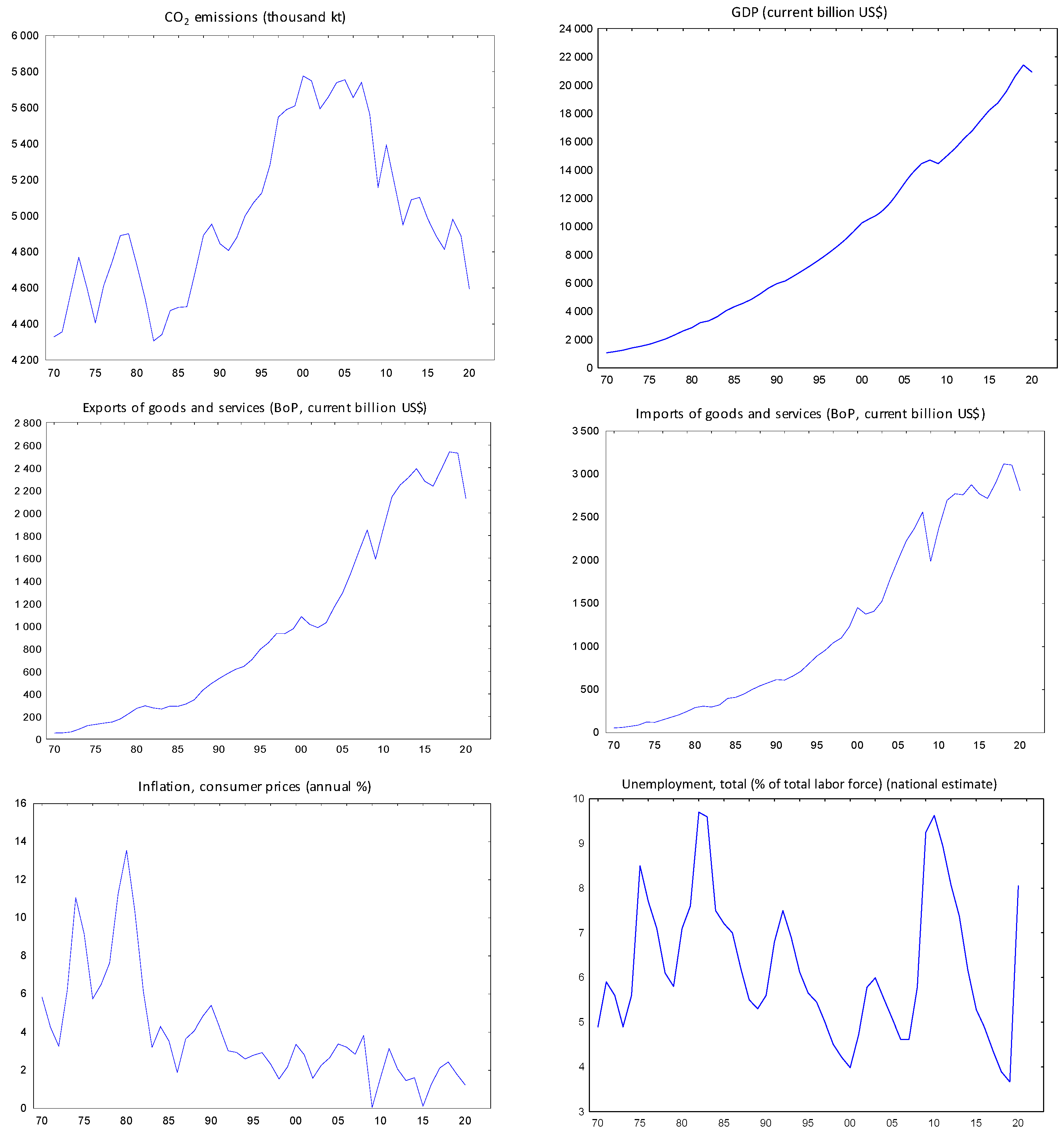


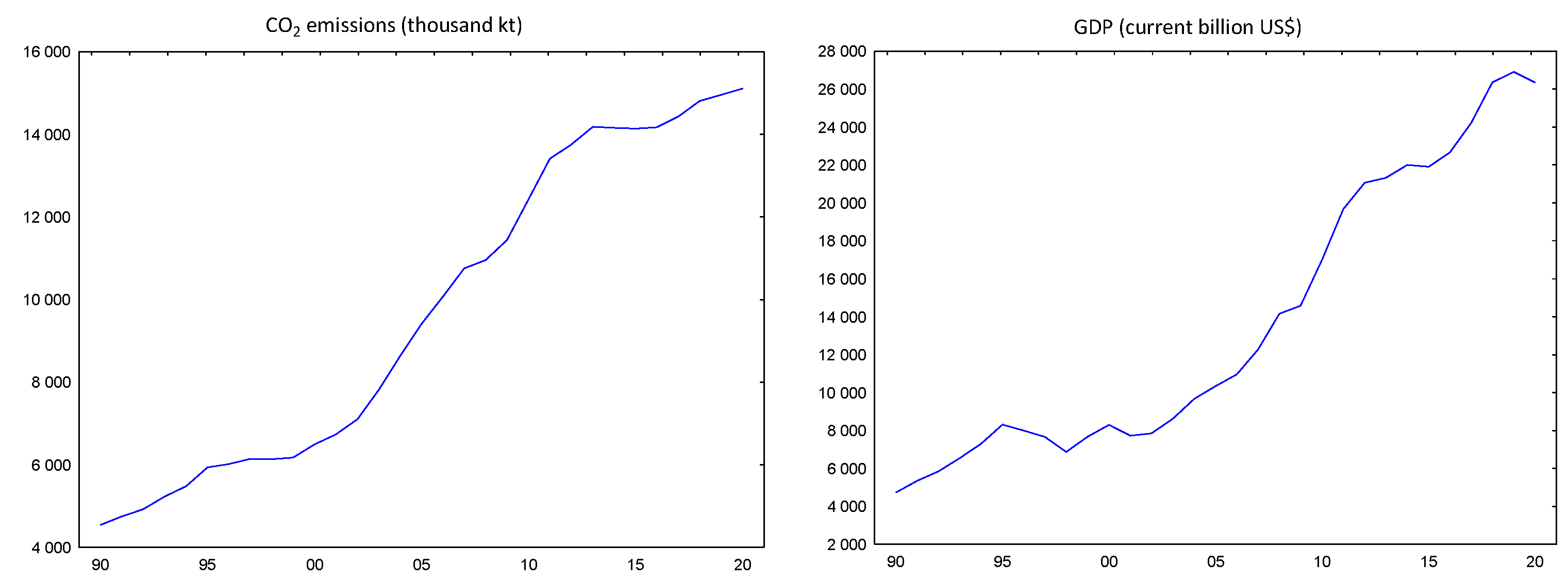
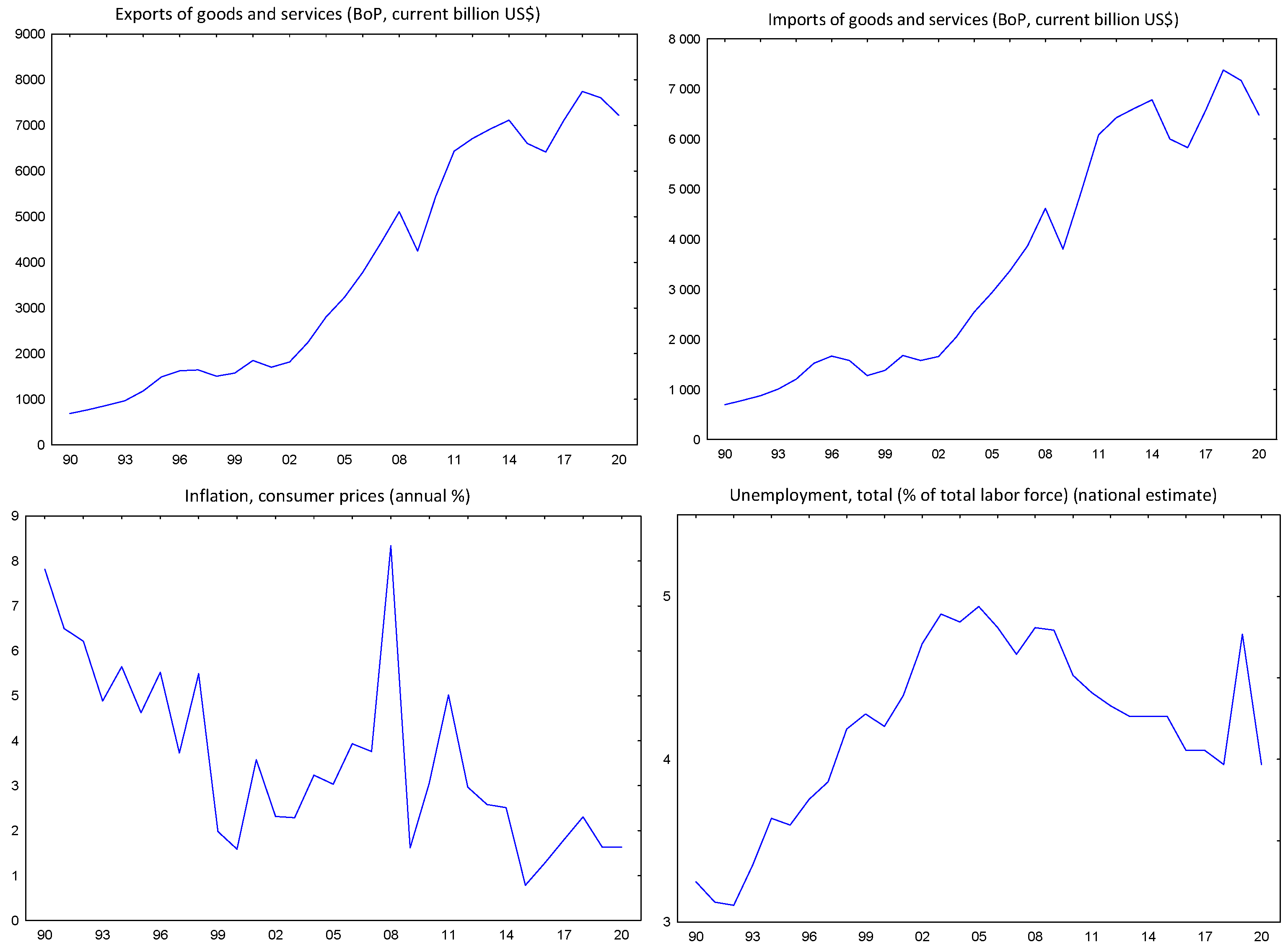
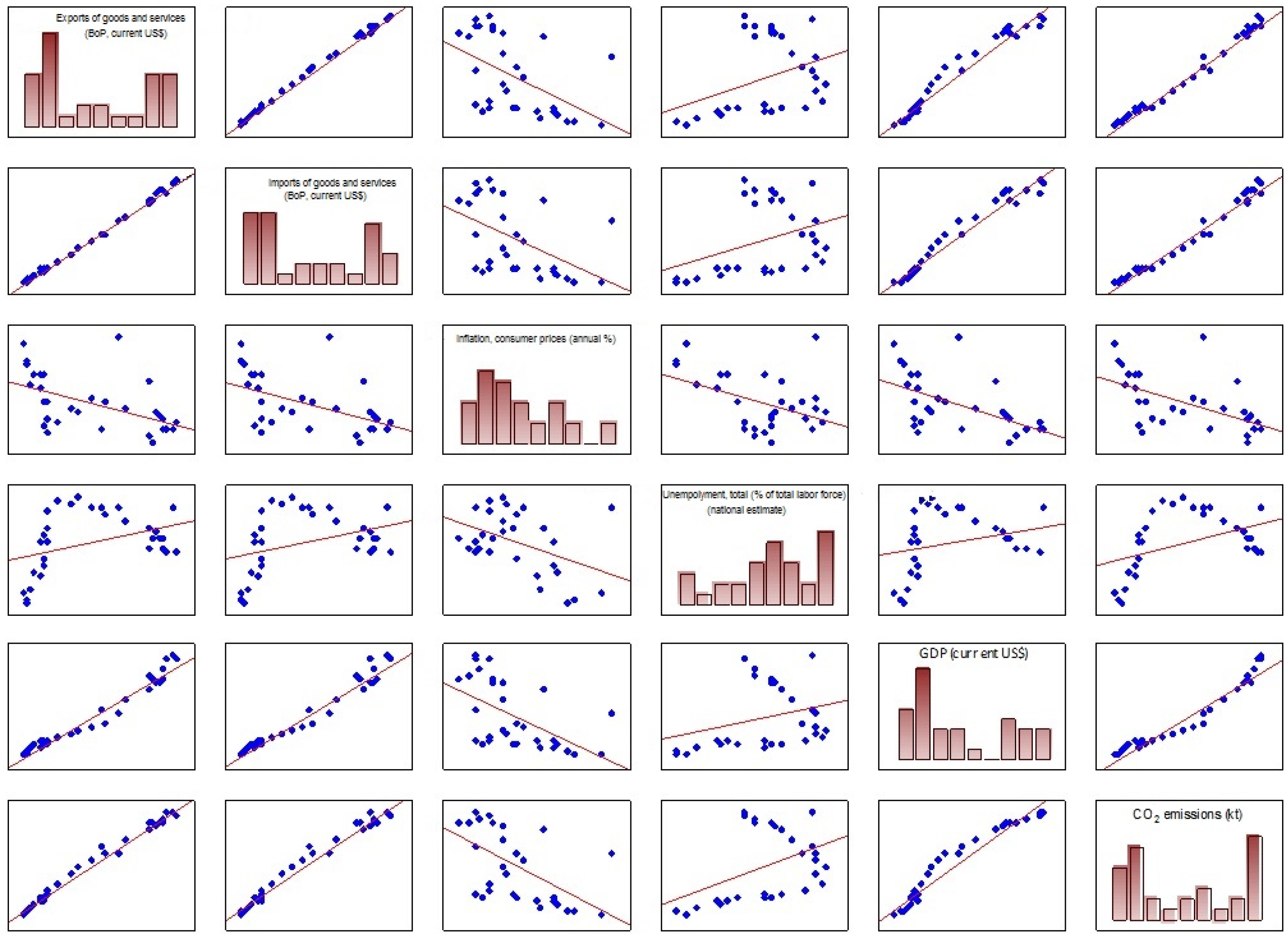
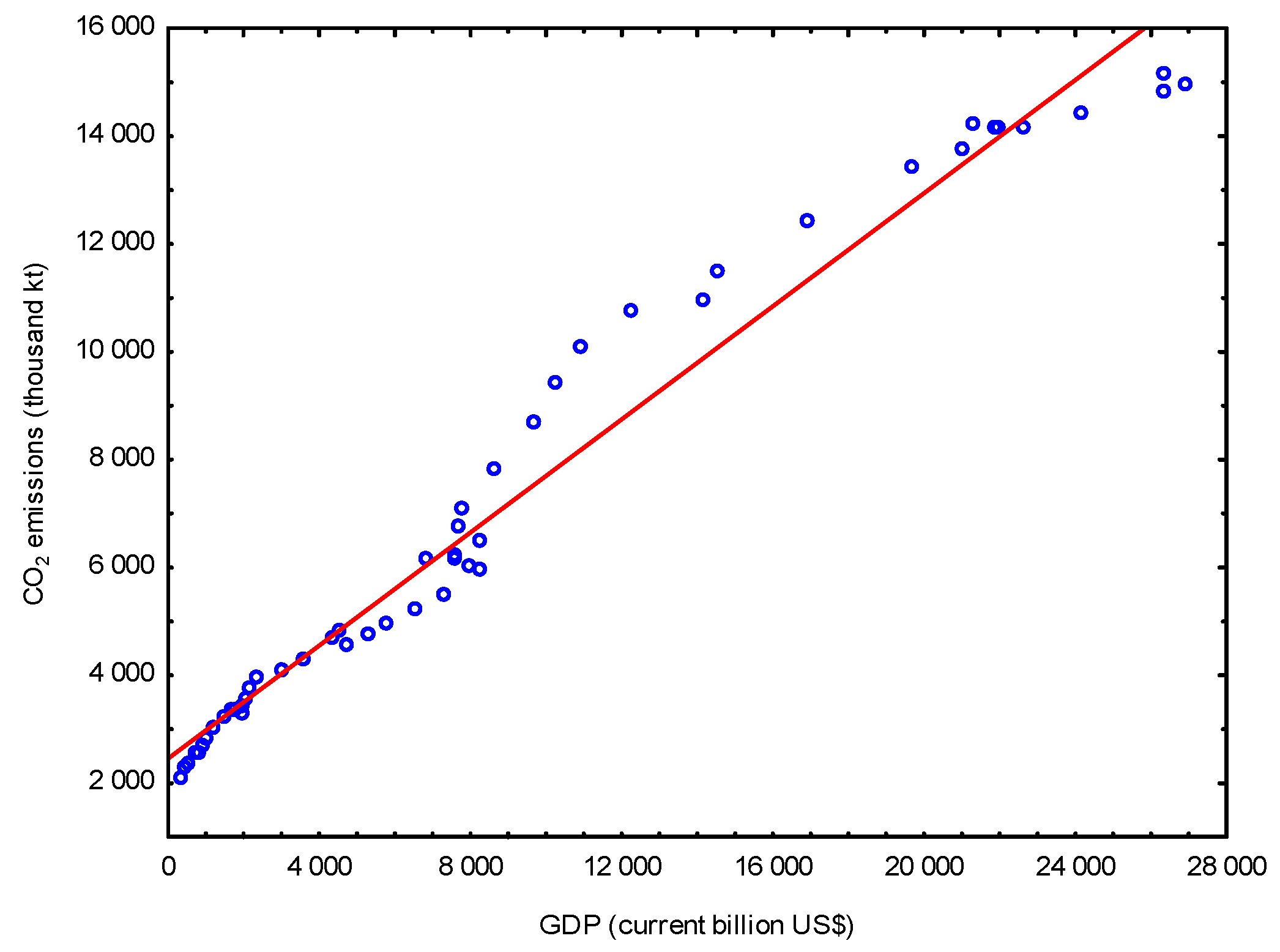
| CO2 Emissions (kt) | Exports of Goods and Services (BoP, Current USD) | Imports of Goods and Services (BoP, Current USD) | Inflation, Consumer Prices (Annual %) | Unemployment, Total (% of total Labor Force) (National Estimate) | GDP (Current USD) | |
|---|---|---|---|---|---|---|
| CO2 emissions (kt) | 1.000000 | 0.427974 | 0.483338 | −0.406354 | −0.431853 | 0.481560 |
| Exports of goods and services (BoP, current USD) | 0.427974 | 1.000000 | 0.992203 | −0.612493 | −0.151669 | 0.984062 |
| Imports of goods and services (BoP, current USD) | 0.483338 | 0.992203 | 1.000000 | −0.615909 | −0.168782 | 0.988240 |
| Inflation, consumer prices (annual %) | −0.406354 | −0.612493 | −0.615909 | 1.000000 | 0.115266 | −0.658768 |
| Unemployment, total (% of total labor force) (national estimate) | −0.431853 | −0.151669 | −0.168782 | 0.115266 | 1.000000 | −0.192127 |
| GDP (current USD) | 0.481560 | 0.984062 | 0.988240 | −0.658768 | −0.192127 | 1.000000 |
| Dependent Variable: CO2 Emissions (kt) | ||||
|---|---|---|---|---|
| Method: Least Squares | ||||
| Sample: 1970–2020 | ||||
| Included Observations: 51 | ||||
| Variable | Coefficient | Std. Error | t-Statistic | Prob. |
| Exports of goods and services (BoP, current USD) | −1.70 × 10−6 | 4.53 × 10−7 | −3.64576 | 0.000677 |
| Imports of goods and services (BoP, current USD) | 1.42 × 10−6 | 3.58 × 10−7 | 3.98296 | 0.00024 |
| Inflation, consumer prices (annual %) | −27,190.6 | 20,075.87 | −1.35439 | 0.182227 |
| Unemployment, total (% of total labor force) (national estimate) | −87,566.8 | 29,676.71 | −2.95069 | 0.004974 |
| C | 5,507,272 | 238,311.1 | 23.11 | 0 |
| Multiple R | 0.719077 | |||
| R-squared | 0.517072 | |||
| Adjusted R-squared | 0.475079 | |||
| S.E. of regression | 323,724.6 | |||
| F-statistic | 12.3131 | |||
| Prob(F-statistic) | 0.000001 | |||
| Dependent Variable: CO2 Emissions (kt) | ||||
|---|---|---|---|---|
| Method: Least Squares | ||||
| Sample: 1970–2020 | ||||
| Included Observations: 51 | ||||
| Variable | Coefficient | Std. Error | t-Statistic | Prob. |
| GDP (current USD) | 3.44 × 10−8 | 8.95 × 10−9 | 3.846273 | 0.000347 |
| C | 4,690,573 | 98,091.21 | 47.81848 | 0 |
| Pearson’s r | 0.48156 | |||
| R-squared | 0.2319 | |||
| Adjusted R-squared | 0.216225 | |||
| S.E. of regression | 395,570.9 | |||
| F-statistic | 14.79382 | |||
| Prob(F-statistic) | 0.000347 | |||
| CO2 Emissions (kt) | Exports of Goods and Services (BoP, Current USD) | Imports of Goods and Services (BoP, Current USD) | Inflation, Consumer Prices (Annual %) | Unemployment, Total (% of Total Labor Force) (National Estimate) | GDP (Current USD) | |
|---|---|---|---|---|---|---|
| CO2 emissions (kt) | 1.000000 | 0.993555 | 0.988110 | −0.565898 | 0.441368 | 0.970408 |
| Exports of goods and services (BoP, current USD) | 0.993555 | 1.000000 | 0.998500 | −0.514987 | 0.384849 | 0.980044 |
| Imports of goods and services (BoP, current USD) | 0.988110 | 0.998500 | 1.000000 | −0.503368 | 0.360731 | 0.981295 |
| Inflation, consumer prices (annual %) | −0.565898 | −0.514987 | −0.503368 | 1.000000 | −0.448818 | −0.559441 |
| Unemployment, total (% of total labor force) (national estimate) | 0.441368 | 0.384849 | 0.360731 | −0.448818 | 1.000000 | 0.274526 |
| GDP (current USD) | 0.970408 | 0.980044 | 0.981295 | −0.559441 | 0.274526 | 1.000000 |
| Dependent Variable: CO2 Emissions (kt) | ||||
|---|---|---|---|---|
| Method: Least Squares | ||||
| Sample (Adjusted): 1990–2020 | ||||
| Included Observations: 31 | ||||
| Variable | Coefficient | Std. Error | t-Statistic | Prob. |
| Exports of goods and services (BoP, current USD) | 2.81 × 10−6 | 4.31 × 10−7 | 6.51957 | 6.53 × 10−7 |
| Imports of goods and services (BoP, current USD) | −1.50 × 10−6 | 4.58 × 10−7 | −3.21664 | 0.003457 |
| Inflation, consumer prices (annual %) | −98,154.3 | 32,696.88 | −3.00195 | 0.005858 |
| Unemployment, total (% of total labor force) (national estimate) | 208,544.1 | 121,696.8 | 1.713636 | 0.098496 |
| C | 3,968,322.2 | 852,329.3 | 4.6559 | 0.0001 |
| Multiple R | 0.9976096 | |||
| R-squared | 0.9952249 | |||
| Adjusted R-squared | 0.9942699 | |||
| S.E. of regression | 288,708.5 | |||
| F-statistic | 1042.096 | |||
| Prob(F-statistic) | 0 | |||
| Dependent Variable: CO2 Emissions (kt) | ||||
|---|---|---|---|---|
| Method: Least Squares | ||||
| Sample: 1970–2020 | ||||
| Included Observations: 51 | ||||
| Variable | Coefficient | Std. Error | t-Statistic | Prob. |
| GDP (current USD) | 5.24 × 10−7 | 1.30 × 10−8 | 40.27305 | 0 |
| C | 2,453,665 | 157,671.2 | 15.56191 | 0 |
| Pearson’s r | 0.985228 | |||
| R-squared | 0.970675 | |||
| Adjusted R-squared | 0.970076 | |||
| S.E. of regression | 751,972.9 | |||
| F-statistic | 1621.918 | |||
| Prob(F-statistic) | 0 | |||
Publisher’s Note: MDPI stays neutral with regard to jurisdictional claims in published maps and institutional affiliations. |
© 2022 by the authors. Licensee MDPI, Basel, Switzerland. This article is an open access article distributed under the terms and conditions of the Creative Commons Attribution (CC BY) license (https://creativecommons.org/licenses/by/4.0/).
Share and Cite
Shpak, N.; Ohinok, S.; Kulyniak, I.; Sroka, W.; Fedun, Y.; Ginevičius, R.; Cygler, J. CO2 Emissions and Macroeconomic Indicators: Analysis of the Most Polluted Regions in the World. Energies 2022, 15, 2928. https://doi.org/10.3390/en15082928
Shpak N, Ohinok S, Kulyniak I, Sroka W, Fedun Y, Ginevičius R, Cygler J. CO2 Emissions and Macroeconomic Indicators: Analysis of the Most Polluted Regions in the World. Energies. 2022; 15(8):2928. https://doi.org/10.3390/en15082928
Chicago/Turabian StyleShpak, Nestor, Solomiya Ohinok, Ihor Kulyniak, Włodzimierz Sroka, Yuriy Fedun, Romualdas Ginevičius, and Joanna Cygler. 2022. "CO2 Emissions and Macroeconomic Indicators: Analysis of the Most Polluted Regions in the World" Energies 15, no. 8: 2928. https://doi.org/10.3390/en15082928
APA StyleShpak, N., Ohinok, S., Kulyniak, I., Sroka, W., Fedun, Y., Ginevičius, R., & Cygler, J. (2022). CO2 Emissions and Macroeconomic Indicators: Analysis of the Most Polluted Regions in the World. Energies, 15(8), 2928. https://doi.org/10.3390/en15082928








